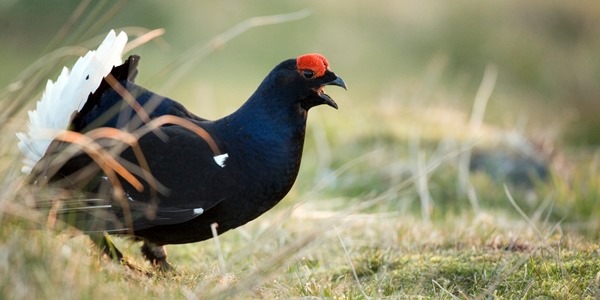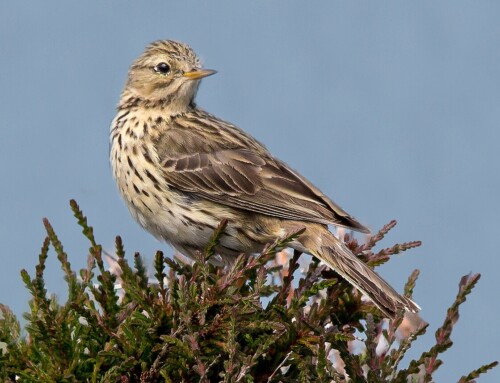Could the creation of new native woodland contribute to landscape-scale recovery of black grouse after decades of decline?
LINKED PAPER
Native woodland creation is associated with increase in a Black Grouse Lyrurus tetrix population. Scridel, D., Groom J.D. & Douglas, D.J.T. 2017. Bird Study. DOI: 10.1080/00063657.2016.1273879. VIEW
In the UK, reforestation initiatives are likely to result in notable increases in woodland cover over coming decades, including areas of new native woodland. Large-scale native woodland restoration is expected to benefit woodland biodiversity, however the benefits and costs of this habitat change have received little research attention. Much woodland expansion is expected to take place in upland areas that do not host prime agricultural land, but support important breeding bird communities. Our recent paper examined how Black Grouse, a key bird of the woodland-moorland interface in these upland areas, respond to native woodland creation in Scotland, and here we discuss the results and the potential management implications of future woodland creation.
Following historic deforestation, the UK is currently the second-least wooded country in Europe with only 12% woodland cover. The formation of the Forestry Commission in 1919 was intended to restore timber reserves following the 1914-18 war, and over subsequent decades large areas were planted. Much of this comprised fast-growing non-native species such as Stika spruce Picea sitchensis, with well-documented impacts in some areas such as the Flow Country. In recent years, a new push for reforestation has emerged. This includes government policies to increase woodland cover for a range of purposes including timber production, carbon sequestration and social benefits (recreational experiences, cultural landscape, improve people physical and mental health). Non-governmental initiatives, such as rewilding, are also driving a push for increased woodland cover. What is clear is that the UK is likely to see increased woodland cover over coming decades. Much of this may take place in marginal upland areas, particularly above the limits of enclosed agriculture, on land of lower agricultural productivity.

A typical bird species of the transition between woodland and open moorland is the Black Grouse Lyrurus tetrix. Formerly widespread across Britain, numbers and range declined dramatically during the 1900s, with a substantial reduction from 25,000 males estimated in the early 1990s (Baines & Hudson 1995) to 5,078 males in 2005 (Sim et al. 2008). For this reason Black Grouse is classified as a UK Red-listed species of high conservation concern (Eaton et al. 2015).
In one well studied population in Tayside, in the core Scottish range, numbers declined by 70% from 1990 to 2002, with maturation and canopy closure of commercial conifer woodland planted over 20 years previously, and the presumed loss of important field- layer vegetation resulting from this, accounting for much of this decline (Pearce-Higgins et al. 2007). Monitoring by a dedicated volunteer group in the area suggested that the population had subsequently increased, but the reasons for this had not been examined. Within the study area, it is apparent that extensive planting of native woodland had taken place over recent decades, under various government-funded Woodland Grant Schemes and rural development programs. These native woodlands are expected to contain the type of habitat that Black Grouse associate with, and in this study we were therefore interested in examining whether native woodland creation could explain the recent increase in the Black Grouse population.

Black Grouse are a lekking species, with males displaying at lek sites in the spring. The females are well camouflaged and difficult to survey, so counting the number of males across leks in the study area is a good way of assessing changes in their abundance between years. For the study, we combined data on lek counts with maps of habitat types across the study area. We examined what habitat and other environmental measures (such as altitude) were associated with the location, size and change in size of leks. We conducted the analyses for different distance bands around leks that relate to various aspects of Black Grouse ecology. We also visited many of the woodland plots in the study area to measure tree cover and the field layer vegetation, which is known to be important for breeding Black Grouse.
Analysis of changes in Black Grouse from 2002-2012 found that abundance increased by 90%, from 270 to 513 males. We found that leks were most likely to occur where there was less commercial woodland edge (expected to be mainly conifer forestry), at mid- altitudes of 350–400 m asl and where moorland cover was approximately 70–80% of land area, all within 500m of leks. Leks were also associated with a greater area of new native woodland edge within a 1500m radius, and within this radius, 79% (92/117) of leks contained new native woodland edge. Leks were also more likely to occur where there was a lower area of enclosed land within a 3000m radius. Recently formed leks (from 2004) were most likely to occur at mid-altitudes (400–450 m) and where there was a greater amount of new native woodland edge, and less likely to occur where there was a greater amount of commercial woodland edge, within 500 m. Similarly, we found that leks were larger where there was less commercial woodland edge within 500 m, and where there was a greater area of new native woodland, and a lower amount of existing deciduous woodland edge, within 1500m. Changes in lek size (between 2002–04 and 2010–12) were significantly correlated with the area of new native woodland within a 1500 m radius of leks, with increase in lek size greatest where there was approximately 30% new native woodland cover within 1500m of leks (equivalent to 2.1 km2 of new native woodland within this radius). As new native woodland area increased above this, population increases were lower, and where new native woodland comprised more than 65% of habitat, populations declined. Interestingly, we found a significant negative relationship between change in lek size and the age of surrounding new native woodland at 1500 m. The greatest increases in lek size occurred where new native woodland was approximately 5 years since establishment. Temporal change in lek size remained positive where new native woodland within 1500 m was up to 20 years since establishment, but leks declined in size where new native woodland was older than this.

We found that the percentage cover of plants that are important for breeding Black Grouse, such as common heather Calluna vulgaris, purple moor grass Molinia caerulea and wavy hair grass Deschampsia flexuosa was higher in new native woodland plots than the surrounding moorland. The cover of cowberry, common cottongrass Eriophorum angustifolium, hare’s-tail cottongrass, Eriophorum vaginatum, deergrass Trichophorum cespitosum, other grasses, soft rush Juncus effusus and bracken Pteridium aquilinum was significantly lower in new native woodland plots. The cover of bilberry was marginally non-significantly greater in new native woodland. These results may be explained by the fact that new native woodland plots represent former moorland that has been fenced to exclude herbivorous grazers (deer, sheep) to enable young tree development, and field-layer vegetation is likely to have experience consequent flush of regrowth compared to the usually unfenced open moorlands.
Our study shows that further expansion of native woodland may indeed benefit Black Grouse. However, the finding that Black Grouse decline as the age of woodland plots increases suggest that, to maintain the benefit of native woodland plots for longer, active management may be required. This could include the use of grazing to manage the important field layer vegetation and stimulate new growth at periodic intervals. If new woodland can be managed to maintain the benefits, then woodland expansion has the potential to make a positive contribution to the conservation of woodland species like the Black Grouse, after decades of decline.
Acknowledgements
We are grateful to the Perthshire Black Grouse Study Group, in particular Jonathan Groom, Claire Smith, for the provision of annual count data and environmental data. Adam Butler, Staffan Roos and Alex Sansom provided statistical advice. Comments from Chris Rollie, Vicki Swales and Jeremy Wilson improved earlier drafts of the article.
References and further reading
Pearce-Higgins, J.W., Grant, M.C., Robinson, M.C. & Haysom, S.L. 2007. The role of forest maturation in causing the decline of Black Grouse Tetrao tetrix. IBIS 149: 143–155. VIEW
Sim, I.M.W., Eaton, M.A., Setchfield, R.P., Warren, P.K. & Lindley, P. 2008. Abundance of male Black Grouse Tetrao tetrix in Britain in 2005, and change since 1995–96. Bird Study 55: 304–313. VIEW
White, P.J.C., Warren, P. & Baines, D. 2013. Forest expansion in Scotland and its potential effects on Black Grouse Tetrao tetrix conservation. For. Ecol. Manage. 308: 145–152. VIEW
Image credit
Featured image: Male Black Grouse, Lyrurus tetrix © RSPB
Blog posts express the views of the individual author(s) and not those of the BOU.
If you want to write about your research in #theBOUblog, then please see here.





